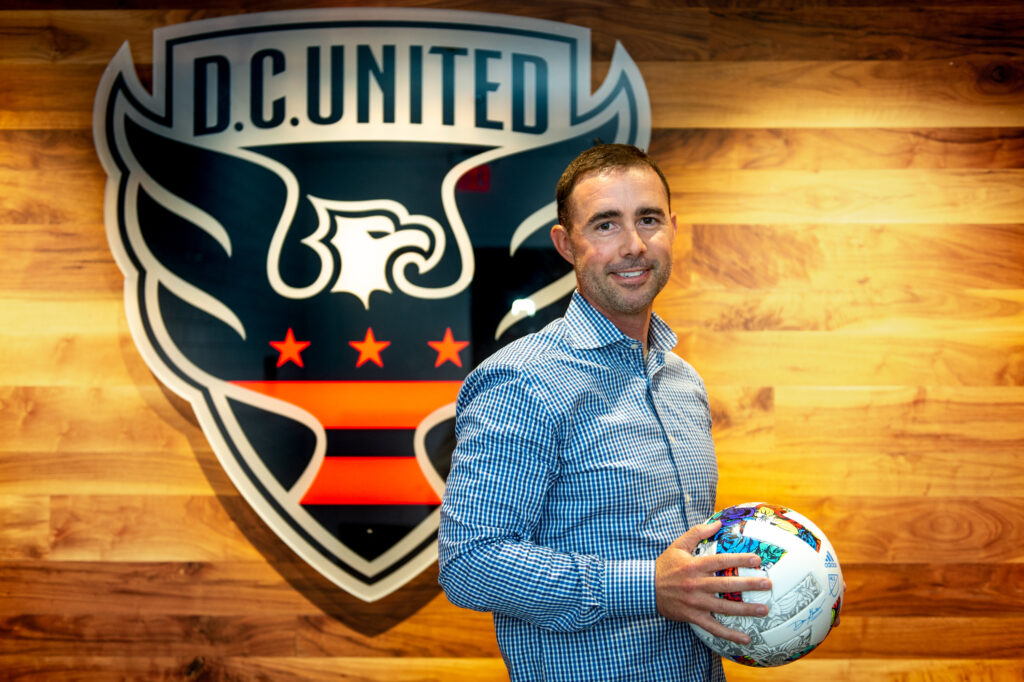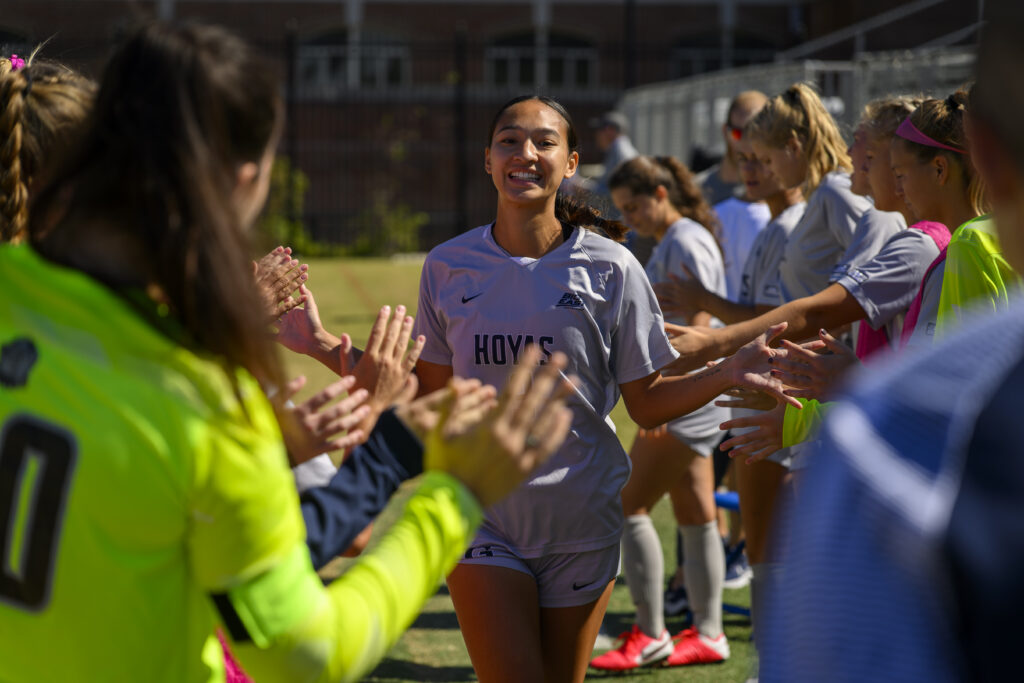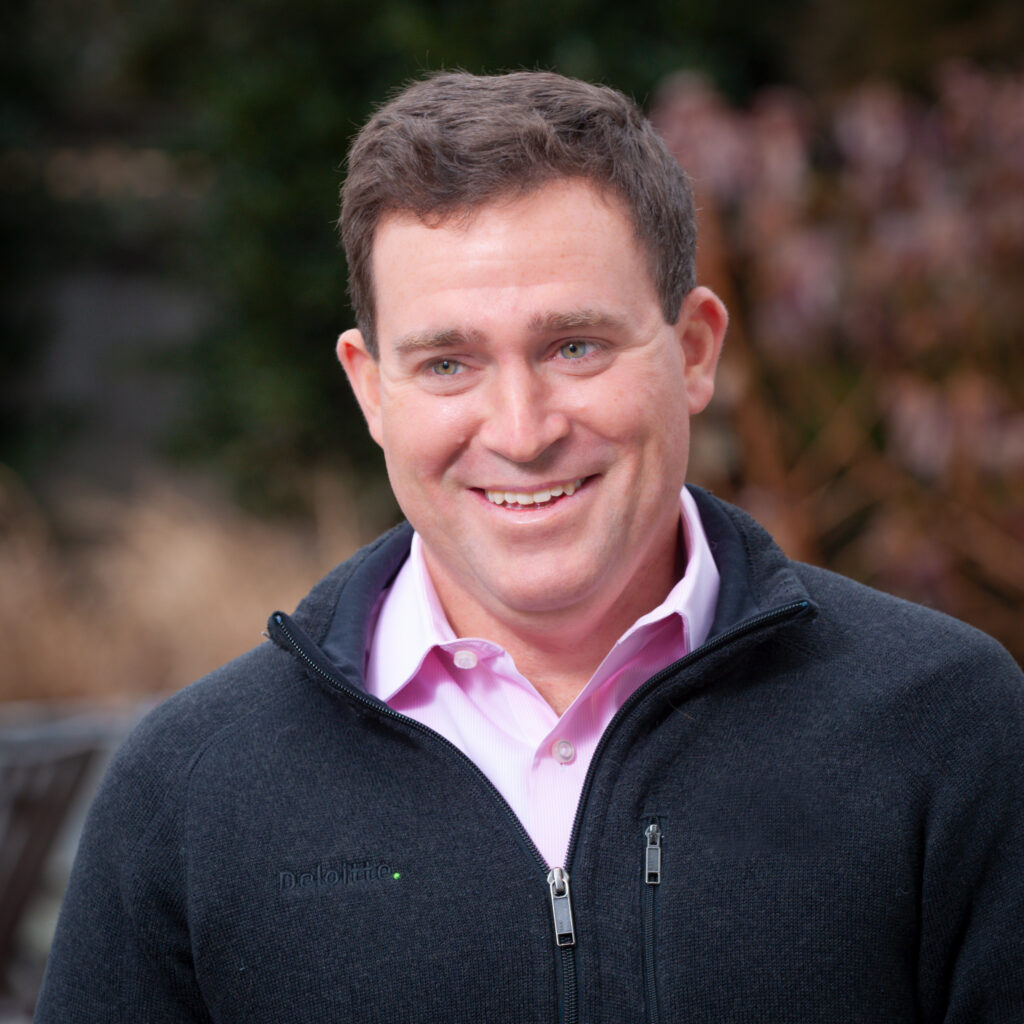Making a Run – Is the Beautiful Game Becoming America’s Pastime?
In February of this year, the Major League Soccer team D.C. United unveiled the “Hall of Heroes”—a massive mural in the foyer of its home stadium, Audi Field, highlighting the city’s professional soccer championships and featuring legendary players who have graced its fields over the years.
The mural’s production was led by Devin Talbott (MBA/JD’03), part owner of D.C. United and founder and managing partner of the investment firm Enlightenment Capital, which sponsored the project. The mural has special meaning to Talbott, who grew up in the D.C. area and watched one of the wall’s featured athletes—legendary Dutch midfielder John Cruyff—play for the now-defunct Washington Diplomats from 1979 to 1981. “No one really knew what soccer was around here back then,” says Talbott. “But there were glimmers of what could be.”
The mural has evidence of that realized future, too, including an image of former United forward and manager Wayne Rooney, an English football legend. American soccer has flourished since the era of Cruyff ’s tenure, when it was on an upswing that proved unsustainable; the Diplomats and the professional league they played in folded just three years after he left the team in 1981. But the fire was lit: That same year, only some 200,000 U.S. high schoolers played soccer; 40 years later, that number has quadrupled to 800,000. Major League Soccer has seen consistent growth, too, now poised to have 30 teams in just over three decades—faster growth than any other major sports league in North America. “The trajectory of American soccer is not just positive,” says Talbott. “It’s exponential.”
Becoming a sports owner wasn’t always the game plan for Talbott. He had played midfielder at Amherst College and had a vision of becoming a soccer-specific sports agent. “I was heavily influenced by Jerry McGuire,” he says with a laugh. At McDonough, he started working part-time at the Carlyle Group in their nascent asset management group and was enamored with the hybrid mix of quantitative and qualitative work, fundraising, and business building. He went on to work at TCG Financial Partners and then to the hedge fund D. E. Shaw, where he helped establish the group’s Washington, D.C.-area office and built out its defense and government businesses. His love of soccer remained, but the idea of involvement at an ownership level, he says, was relatively recent. “It only really came into sharp relief during the construction of this business,” Talbott says of Enlightenment Capital, which he launched in 2012.

Devin Talbott (MBA/JD’03)
In 2021, Talbott was part of a group of investors—which included Jenna Bush Hager and Chelsea Clinton—who bought into the Washington Spirit, a National Women’s Soccer League (NWSL) team, which would go onto win its first league championship later that season. About a year later, he became a part owner of D.C. United. “I just love the game,” he says of his motivation to invest in professional teams. “I love what it can do for a person and a community.” (Talbott also serves on the board of DC Scores, a nonprofit that provides after-school and summer programming, combining soccer, poetry, and service learning.)
Talbott has happily watched the gathering swell of soccer interest. He was at David Beckham’s rain-drenched debut for the LA Galaxy in front of a sell-out crowd at RFK stadium in 2007. “That was a step function,” says Talbott. Argentinian icon Lionel Messi’s high-profile move to MLS’s Inter Miami in July? “That’s been a two-step function.” The announcement of Messi’s signing alone saw the Miami franchise gain 10 million new followers on Instagram.
Early on, though, the sport had to find its footing in a crowded American sports market, Talbott says, which sometimes resulted in unsuccessful efforts by Major League Soccer to Americanize the game, like adding shootouts to eliminate draws.
“I think it is now a little bit more faithful to the origins of soccer and how soccer is played overseas, which has been a good thing,” he says. “And especially with this younger generation, there is much more appreciation for the two 45-minute halves with intense competition and no breaks. It’s incredibly hard, and you’ve got to earn your goals.”
Professional leagues have been happy to meet rising demands. When the MLS announced it expected to add a 30th team by 2025, it left the door open for even more expansion.
“Never thought we’d be at 28, never thought we’d be at 29—we say we’re going to stop at 30 but the other major leagues are larger than that,” MLS commissioner Don Garber told the media in February, “I don’t ever say never. In Major League Soccer, there are many other markets that are opportunities for us.”
The NWSL announced expected expansion plans in June, with two women’s teams likely to be added in 2024 and two more teams to join in 2026—which would double the league’s original eight-team structure. Another professional women’s league, USL Super League, also announced its intentions to launch in 2024 as a 10- to 12-team league.
All of this energy is attracting capital, too, says Talbott, noting a recent 10-year, $2.5 billion deal between Apple and the MLS that allows subscribers to stream every league match. “It’s the first major sports league to go all streaming—not just in this country, but globally.” Adidas also renewed its jersey and apparel deal with the MLS in February, extending the agreement through 2030 to the tune of $830 million. And that new MLS expansion team? The league announced in May that those rights were awarded to San Diego, thanks in part to financial backing from Man Capital, the investment arm of the Egyptian conglomerate the Mansour Group, which is led by CEO Loufty Mansour (B’04). Man Capital also owns a top-flight Danish club and Right to Dream, a soccer academy based in Ghana which has produced several European players and is “dedicated to expanding people’s understanding of excellence through football.”
“You’re starting to see sponsors and big businesses line up behind it, both on the men’s side and the women’s side,” he says. “And they’re not doing that for charitable reasons. They’re doing it because it’s a market with a short attention span and lots of options— and that is difficult to access. The game gives them an avenue to reach a really attractive consumer base.”
American soccer’s reputation has grown, too, says Talbott, who considers the MLS to be a top five league in the world now. “Wayne Rooney came here as a player and had a great couple years, and then started managing here,” says Talbott. (Rooney has since been appointed manager of Birmingham City, a professional team in the second tier of English football.). “He brought legitimacy, and he was trying to use MLS to get back to the Premier League. So people aren’t looking at MLS as a place to go toward the end of their careers. They’re looking at it as a place to build a career. And maybe as a launching point to one of the bigger leagues in Europe.”
There is still room to grow, though, says Talbott. He recently took a trip with his son where they saw three matches in England in three days, including watching English Premier League heavyweight Liverpool play a fierce match in London against Crystal Palace. Sitting near the vocal Liverpool supporters’ section, Talbott soaked in the electric atmosphere. “It is probably going to take some time for MLS to get to that level,” he says. “But the viewing experience and the energy and the song and the passion— it wasn’t far off from being at a D.C. United game.”
Growing the Game
Maya Alcantara (MS-ESM’23), midfielder for Georgetown and the Philippines women’s national team, on building the foundations for the sport’s future growth.

Maya Alcantara (MS-ESM’23)
Maya Alcantara grew up on the soccer sidelines, spending countless hours watching her older sister, a high school standout who eventually played at UC Riverside. “So naturally I wanted to be my older sister,” says Alcantara. “She motivated me and instilled in me this idea that I can do what she could do—and more. So I had no doubt in my mind that I wanted to play college and pro just from watching her and her teammates.”
Alcantara made good on that vision, playing at St. Mary’s and Georgetown before being tapped to represent the Philippines in the 2023 Women’s World Cup. She’s been thrilled to see the growth of the game both in the United States and globally. “When I was a little girl, you could only see the U.S. Women’s World Cup matches on TV,” says Alcantara. “Now every match is on TV.” There is still more to be done, though. Teams like the Philippines, she found, don’t have the deep soccer infrastructure and funding of teams like the United States, which can impact training. “Some federations aren’t as lucky as we are, so we still have to keep pushing for things. We’re very grateful for what we have, but that doesn’t mean that we can’t ask for more,” says Alcantara. Included in those asks: A fair wage. “It is not about money. We do it for the love of the game and for our country. But the reality of it is that I was looking for jobs on LinkedIn and finishing classes during the World Cup because we are not getting compensated enough. We want to be supported not just as a player, but as people.”
Those foundations are critical to improving performance—which is itself critical to bringing even more women into the game. “You need to see someone do it to believe that you could do it as well,” says Alcantara. And just like her sister inspired her, she’s now working to inspire young girls across the Philippines. “We had these meet-and-greets with fans after the World Cup, and we would ask the little girls, ‘Are you playing soccer?’ And they’d say, ‘Not yet, but we just signed up,’” Alcantara recounts. “So it took them seeing us on the big screen to sign up—and that’s what we really want.”
A Wider Net
The pathway to growing the game, says Dan Helfrich (SFS’98, MBA’99) is making sure everyone has a chance to play.
When Dan Helfrich (SFS’98, MBA’99) played soccer at Georgetown—a career that included the men’s first-ever NCAA tournament victory in 1997—European soccer was relatively inaccessible. “Trying to find a German Bundesliga, English Premier League, or Italian Serie A match on TV was a heroic feat,” says Helfrich, chair and CEO of Deloitte Consulting LLP and the play-by-play voice of the Georgetown men’s soccer team. There was no real national outlet for the sport, either, with “no meaningful women’s domestic professional league and a fledgling, at the time, men’s domestic league.”

Dan Helfrich (SFS’98, MBA’99)
What has changed in the more than a quarter century since then? Helfrich says a big factor has been the increased national focus on diversity, equity, and inclusion. “There is no sport with the cultural heterogeneity and the cultural traditions that soccer has,” he says. “We have this incredible country, founded by immigrants—most of whom have come from countries where soccer is the most identifiable sporting tradition—and it creates this incredible tapestry to have conversations about equity and conversations about inclusion.” It has spurred, too, he notes, the rise of the U.S. women’s team as a national sporting power and has been critical to elevating national conversations about subjects like pay equity.
Growing beyond these gains, says Helfrich, will require a continued focus on the grassroots. “The accessibility of the game to all communities has been a big focus of U.S. soccer, and there’s been good progress made. As we look over the next 10 to 20 years, that becomes even more important,” says Helfrich. “We need to make sure the best coaching, the best facilities, the best infrastructure is accessible more consistently and equitably than it is today, and particularly in underserved communities.” If we get that right, he argues, we will see participation increase from a broader range of socio economic spectrums. “And we also will see the most elite dimensions of the sport in the United States—like the men’s and women’s national teams—grow even more competitive.”
Good media wouldn’t hurt, either, says the broadcast booth veteran. “There’s a potential investment in marketing and promoting the incredible range of athletes on both the men’s and women’s side in the 17- to 27-year old demographic right now, who happen to represent an incredible array of races and ethnicities, an incredible array of personalities, and an incredible array of life stories and life stories— including the lives of their parents, many of whom were immigrants into this country,” says Helfrich. “There is a marketing and storytelling dimension that is incredibly important.”
This story was originally featured in the Georgetown Business Fall 2023 Magazine.
